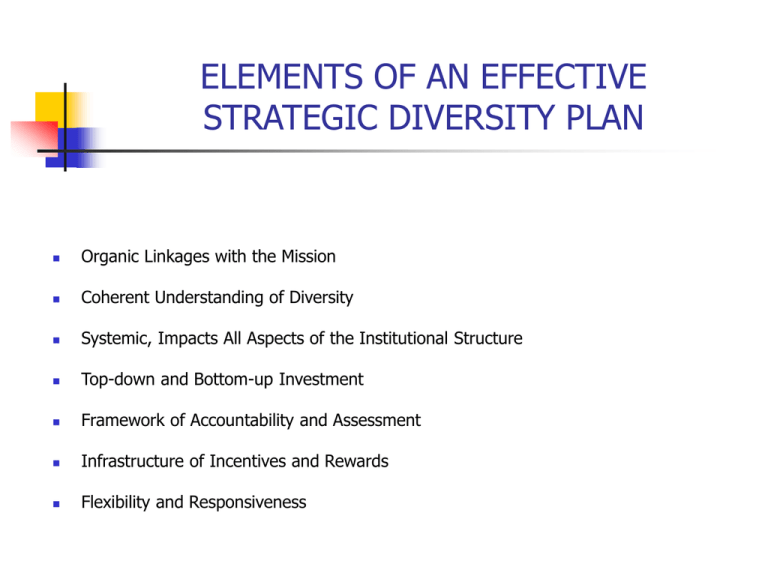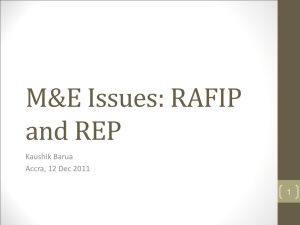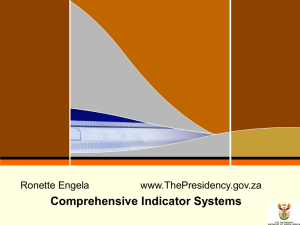elements of an effective diversity plan
advertisement

ELEMENTS OF AN EFFECTIVE STRATEGIC DIVERSITY PLAN Organic Linkages with the Mission Coherent Understanding of Diversity Systemic, Impacts All Aspects of the Institutional Structure Top-down and Bottom-up Investment Framework of Accountability and Assessment Infrastructure of Incentives and Rewards Flexibility and Responsiveness FRAMING AN UNDERSTANDING OF DIVERSITY Institutional Transformation Educational/School Mission Response to Intolerant Climate Representation Systemic Interdependency Campus Climate/ Inter-cultural Relations Education/ Scholarship Student Access/ Success Transformation STUDENT ACCESS AND SUCCESS (Race, Ethnicity, Gender) Access Success • Yield • GPAs • Recruitment • Course Completions • Enrollment • Honors • Participation Rates • Retention • Persistence • Graduation Rates • • Graduate School Attendance Engagement CAMPUS CLIMATE/INTER-CULTURAL RELATIONS (Race, Ethnicity, Gender Sexual Orientation, Language, Religion, Age, Nationality, Class, and Ability) Perceptions of Campus Climate Quality of Inter-cultural Relations Education and Scholarship (all groups) New Academic Fields New Course Content New Pedagogies Diversity Requirements INSTITUTIONAL TRANSFORMATION Congruence of Leadership Statements with Diversity Agenda Incentive and Rewards Structures to Support Participation Policies to Prevent and Address Discrimination Strategic Hiring Initiatives Healthy Interactions With Community Capacity for and Visibility of Institutional Leadership for Diversity Diversity Plan Principles Negative outcomes that are correlated with group membership are suspect and should prompt institutional inquiry and intervention. The Diversity Plan tracks negative outcomes that have a basis in group membership, not individuals who are members of groups. Strategies that eliminate group-based disadvantage confer benefits on more than their intended targets and improve the institution as a whole. The plan must measure progress in terms of equity and not merely positive numerical change. Without a sufficient infrastructure of support (incentives and rewards, policy development, accountability mechanisms) the diversity plan has no teeth Diversity and excellence must be viewed as commutual Diversity Plan Resources The Goals Ten goals across 4 dimensions of the institution The Institutional Indicators (Institutional Measures of Progress) The macro-level measures used to gauge the success of the Plan from a broad institutional perspective. Derived from Strategic Plan Planning Guidelines Includes an introduction that frames an understanding of the Plan; the diversity goals; strategy templates and submission criteria; and timelines for planning and review. The Strategic Plans (Unit-level planning and assessment of progress) Summary Progress Reports “Inventory of Campus Diversity Resources” Annual update of campus resources in support of diversity agenda. DIVERSITY PLAN GOALS STUDENT ACCESS AND SUCCESS Goal/Outcome 1: Support the Enrollment of a Diverse Student Body Goal/Outcome 2: Support the Retention and Success of a Diverse Student Body CAMPUS CLIMATE AND INTERGROUP RELATIONS Goal/Outcome 3: Foster a Campus Climate that is Welcoming to All Goal/Outcome 4: Foster Inter-cultural Respect, Communication, and Collaboration EDUCATION & SCHOLARSHIP Goal/Outcome 5: Support the Incorporation of Diversity and Inclusion Across the Curriculum INSTITUTIONAL TRANSFORMATION Goal/Outcome 6: Enhance the Recruitment and Retention of Diverse Faculty, Staff and Administrators Goal/Outcome 7: Ensure Accessibility of Facilities and Programs Goal/Outcome 8: Foster Healthy Relationships with our Community Partners Goal/Outcome 9: Enhance the Capacity for and Visibility of Institutional Diversity Leadership Goal/Outcome 10: Institutionalize a Culture of Diversity Planning and Assessment INSTITUTIONAL INDICATORS Student Access and Success Goal/Outcome 1: Support the Enrollment of a Diverse Student Body Undergraduate Enrollment Indicators Baseline Benchmark Data Source Data Manager Time Frame for Review Yield rates of first-time, fulltime, trad, deg. - seeking undergrad. admitted by race/ethnicity and gender Fall ‘05 Continuous Progress Admissions Data Admissions Annual Evaluation template adapted from James Irvine Foundation Campus Diversity Initiative Evaluation Project. Indicators based on model by Daryl Smith (Diversity Works: The Emerging Picture of How Students Benefit) . INSTITUTIONAL INDICATORS Student Access and Success Goal/Outcome 2: Support the Retention & Success of a Diverse Student Body Undergraduate Graduation Rates Indicators Baseline Benchmark Grad rates for Dec. ’04 – Close the full-time, degree- May, ’05 Gaps seeking undergrads by race/ethnicity, gender, disability, SES, and international status Data Source Data Manager Time Frame for Review Graduation Data Registrar Annual INSTITUTIONAL INDICATORS Campus Climate/Inter-cultural Relations Goal/Outcome 4: Foster a Campus Climate that is Welcoming to All Campus Climate Indicators Baseline Faculty and Fall ’05 staff perceptions of campus climate by race/eth., gender, age, religion, sex. orientation, nationality, and job classification Benchmark Data Source Data Manager Time Frame for Review Close the gaps Employee Survey of Campus Climate DAC, VP for Diversity, Inst. Research, HR Three Years INSTITUTIONAL INDICATORS Education & Scholarship Goal/Outcome 5: Support the incorporation of diversity and inclusion across the curriculum Indicators Baseline Benchmark # of courses offered in support of Core Diversity Requirement TBD TBD # of tenureFall ’05 track faculty hired for specialization in scholarships of diversity Continuous Improvement Data Source College Hiring Files Data Manager Time Frame for Review GDST Annual Academic Deans Annual INSTITUTIONAL INDICATORS Institutional Transformation Goal/Outcome 6: Enhance the Recruitment and Retention of Diverse Faculty, Staff and Administrators Employee Recruitment Indicators Baseline Benchmark Data Source Data Manager Time Frame for Review Utilization analysis of job groups by college Fall ’05 Utilization Affirmative Action Plan Goals Affirmative Action Plan Utilization Analysis Human Resources Annual STRATEGY PLANS Student Access and Success Goal/Outcome 2 Support the Retention and Success of a Diverse Student Body Strategy: Recruit LAC tutors who reflect the racial and gender diversity of the undergraduate population Indicators Baseline # and % of 04 – 05 LAC tutors by Levels race/ethnicity and gender relative to % of participants in undergraduate population Benchmark Data Source Responsible Party Time Frame for Review The diversity of the tutoring staff will meet or exceed the diversity of the student population LAC Records LAC Annual STRATEGY PLANS Campus Climate/Intercultural Relations Goal/Outcome 4: Foster Intercultural respect, communication, and collaboration Strategy: Offer more awareness-enhancing programs, services, and events through such efforts as Theater of Conscience, Heritage Fest, clubs, and organizations that embrace diversity and campus-wide student-oriented diversity programs Indicators Baseline Benchmark Data Source Responsible Party Time Frame for Review # and % of undergrads who participate 04 -05 levels TBD Student Life Records Student Life Annual Participant evaluations of Impact STRATEGY PLANS Education and Scholarship Goal/Outcome 5: Support the Incorporation of Diversity and Inclusion Across the Curriculum Sample Strategy: Department X will collaborate with the Library to produce Xtreme Multicultural Subject Guides as resources for course revision Indicators Baseline Benchmark Data Source # of courses in the department that are revised 04 – 05 levels Continuous Progress Department X Faculty assessments of the Subject Guides Responsible Party Time Frame for Review Annual STRATEGY PLANS Institutional Transformation Goal/Outcome 6: Enhance the Recruitment and Retention of Diverse Faculty, Staff and Administrators Sample Strategy: X will purchase the Doctoral Scholars Directory for use by academic search committees Indicator Baseline Benchmark Data Source # of search committees utilizing this resource 04 – 05 levels (0) At least 50% Search Committee Records # of candidates (or hires) identified through this resource At least 1 Responsible Party X Time Frame for Review Annual STRATEGY PLANS Institutional Transformation Goal/Outcome 9: Enhance the Capacity for and Visibility of Institutional Diversity Leadership Sample Strategy: Planning Unit X will incorporate a diversity statement from the administrator on its web page, in new employee orientations, and in its print publication Indicators Baseline Benchmark Data Source Responsible Party Time Frame for Review Student and/or employee perceptions of Unit commitment to diversity N/A At least 75 % perceive high commitment Survey X Planning Unit X Annual Planning Exercise Goal/Outcome 2: Support the Retention and Success of a Diverse Student Body Goal/Outcome 4: Foster Intercultural Contact and Collaboration Goal/Outcome 6: Goal/Outcome 10: Enhance the Recruitment and Retention of Diverse Faculty, Staff and Administrators Institutionalize a Culture of Diversity Planning and Assessment Strategy: Indicator Baseline Benchmark Data Source Data Managers Time Frame for Review Recommendations for Accountability Guidelines RECOMMENDATION 1: Reporting Chain Divisional/Collegiate Unit-Level Planning ( VPs and Deans) ADVANTAGES: Follows the Natural Leadership Hierarchies Allows for Flexibility Simplicity/Less Administrative Burden More likely to Produce Substantive Effort DISADVANTAGES: ? Recommendations for Accountability Guidelines RECOMMENDATION 2: Plan Time Frame 5 - Year Plan (2005 – 2010) (becomes 6 – year plan during next cycle) ADVANTAGES: DISADVANTAGES:? Alignment with University Strategic Plan Facilitates alignment with Budget Coherency with Mission Allows time for Progress Recommendations for Accountability Guidelines RECOMMENDATION 3: Planning and Assessment Timeline Review and Acceptance of Strategies Semester Prior to Start of Plan (Fall 2005) Annual Review and Summaries of Strategy Progress to the President and University Community Interim and Final Review and Summary of Institution-level Indicators of Progress to the President and University Community ADVANTAGES: DISADVANTAGES: Continuous assessment reinforces culture of diversity planning & assessment Annual summary rewards promising practices and highlights inactivity Allows for ongoing adjustment ? Recommendations for Accountability Guidelines RECOMMENDATION 4: DAC as Standing Oversight Committee with Other Duties as Assigned (additional subcommittee members from planning unit) ADVANTAGES: DISADVANTAGES:? Continuity of DAC role in Plan development Draws upon the existing understanding and commitment of the DAC Vehicle for ongoing capacity development within units Collaborative, not just top-down ELEMENTS OF AN EFFECTIVE DIVERSITY PLAN Coherent Understanding of Diversity Systemic, Impacts All Aspects of the Institutional Structure Organic Linkages with the Mission Top-down and Bottom-up Investment Framework of Accountability and Assessment Infrastructure of Incentives and Rewards Flexibility and Responsiveness






